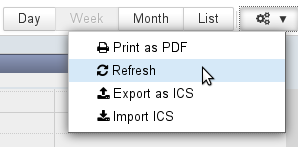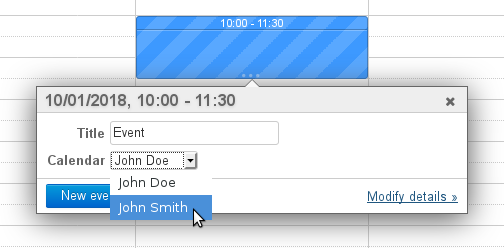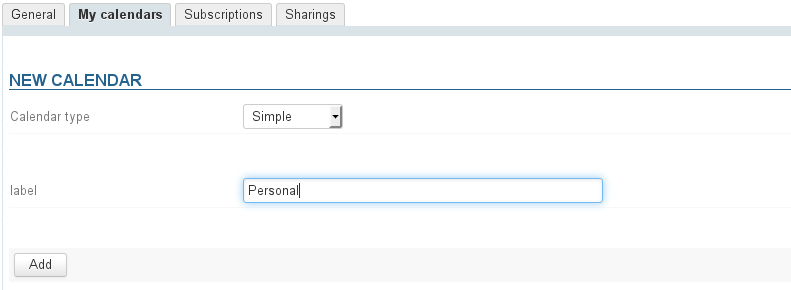Historique de la page
...
| Sv translation | |||||||||||||||||||||||||||||
|---|---|---|---|---|---|---|---|---|---|---|---|---|---|---|---|---|---|---|---|---|---|---|---|---|---|---|---|---|---|
| |||||||||||||||||||||||||||||
Display and navigationThe primary default view of the BlueMind calendar is made up of the following parts:
Events are marked with icons that give you a quick view of their properties:
In BlueMind 3.5 events include more details and offer more customization options. Custom meeting versionsEach participant now has their own version of a meeting. This means they can modify it (location, category, note, etc.) or set a different attendance status for an occurrence of a series of meetings: they can accept the whole series but indicate that they will not attend one or several occurrences, for instance. Organising and participating in meetings
E.g., if John Doe wants to create a new meeting in John Smith's calendar:
Le cas des ressourcesLes ressources fonctionnent comme des utilisateurs. Ainsi, de même que dans le cas général, pour créer un événement directement dans l'agenda de la ressource, l'utilisateur doit avoir le droit "Peut modifier ses événements" et positionner celle-ci en organisatrice. Si l'utilisateur est pourvu d'un simple droit de réservation, il doit alors créer un événement dans son propre agenda et y inviter la ressource. De plus, la version 3.5 améliore les fonctionnalités de réservation de ressources en permettant, dans certains cas, une réservation automatique ou l'empêchement de doubles réservations. Retrouvez plus de détails sur la page consacrée aux ressources.
Le nouveau comportementLes calendriers de domaines ne sont plus considérés comme des entités physiques au même titre que les utilisateurs et ressources. Ces calendriers sont dorénavant considérés comme des calendriers servant à l'information des utilisateurs, pour faire connaître par exemple les jours fériés, les jours de fermeture de l'entreprise, les événements commerciaux (salons, présentations...) ou municipaux (réunion du conseil, exposition, conseil d'école, etc.), les formations, les actions d'une équipe, etc. Par conséquent, les calendriers de domaine ne peuvent plus être positionnés en organisateurs de réunions ni y être invités, comme c'était le cas avec BlueMind 3.0. Nouvelle pratiqueLes agendas de domaine pouvaient être utilisés dans 2 cas :
Invitations and notificationsWhen a meeting is created, if the organizer chooses not to send invitations, participants are not notified by email and the meeting is not shown in their calendar. Similarly, when invitees accept or decline participation, only the meeting organizer receives notifications and centralizes the meeting's information.
This means that participants other than the organizer cannot see other participants' statuses. To see them, they must look at the organizer's version of the meeting, provided the organizer has given them reading rights on their calendar:
Multiple calendarsBlueMind allows users to create and use as many personal calendars as they like and to manage how they are shared the same way they would their default calendar. Creating a new calendarTo create a new calendar:
Editing a calendarTo edit a calendar's name:
Deleting a calendarTo delete a calendar:
Sharing availabilityIn calendar preferences (see above), the "Freebusy" column allows users to select which calendar(s) will be used when other users search their availability to invite them to an event.
Once you've selected the calendar(s), fill in the "freebusy sharing" form:
Sharing can be set as:
PrintingTo print the current view, open the Tools menu at the top right of the main display area: The printing dialog box offers you to print the current view as a calendar or as a list and printing options allow you to preview the selection: The weekly view shown above produces the following pdf file: calendarSemaine.pdf The list view shown above produces the following pdf file: calendarListe.pdf Click "Save" to download the file.
ICS Export and ImportICS exporting and importing is available from the Tools menu at the top right of the main display area: ICS ExportThe dialog box that opens allows you to select the calendar and the events you want to export. By clicking "Export", you are offered to download or open the corresponding ICS file depending on the user's environment configuration: ICS ImportThe dialog box that opens allows you look for a file on your computer and select the calendar in which you want to import the events. You can choose from all the calendars you have write access to: ICS Synchronization |


















